Buildings that blend with nature: why Singapore has them in abundance and Hong Kong doesn’t yet
Architects in Lion City have embraced the idea that humans have an innate desire to connect with nature and incorporated it in building design; Hong Kong’s green walls and podium gardens are a step towards this
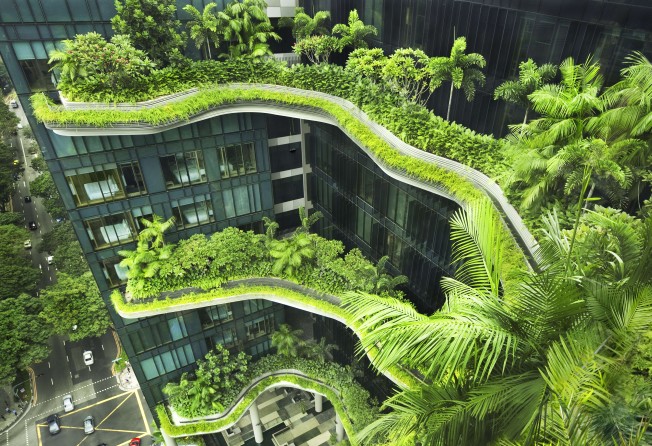
You begin to notice them as soon as you arrive in Singapore: buildings overwhelmed by greenery, steel and glass seemingly reclaimed by the tropical landscape. Then, as you make your way through the city, you notice how many spaces are open to the air, despite the constant heat and humidity that makes every afternoon feel like the dog days of a Hong Kong summer. Singapore isn’t a city in a garden; it’s a city that is a garden.
Richard Hassell and Wong Mun Summ deserve much of the credit. Their Singapore-based architectural practice, WOHA, has dedicated itself to biophilic design, a concept outlined in their new book, Garden City Mega City, which explores the firm’s work and its implications. “It’s something that’s part of us as human beings,” says Hassell. “We love nature.”
That’s the idea at the heart of biophilia, first proposed by the American biologist E.O. Wilson in 1984. He suggested that all humans have an innate desire to connect with nature, even if they have never lived in natural surroundings. Biophilic design translates that desire into the built environment.
“We’re hardwired as a species to affiliate with nature, because in millions of years of development we’re attuned to the sunrise and sunset, the weather, the climate, the seasons, rocks, landscape,” says Keith Griffiths, chairman of Hong Kong-based architecture firm Aedas. “That’s all part of our hard-wiring. Even though we might be born and brought up in a dense urban environment, we’re still naturally attuned to nature. We need to be very aware of that when we’re designing buildings.”
The challenge of biophilic design is to combine that age-old desire for nature with the demands of a modern world that is becoming more urban and more densely populated. The vision of firms like WOHA is not to replicate the sprawling suburban utopia of Frank Lloyd Wright’s Broadacre City, conceived in the 1930s; it is to create high-rise, high-density cities that give a new and more positive meaning to the term “concrete jungle”.
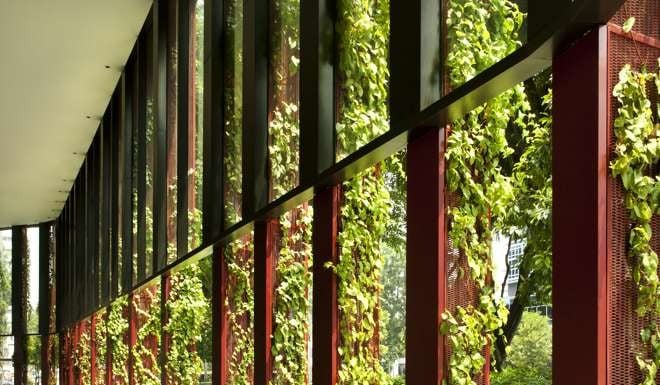
“Being in a biophilic city delivers tremendous benefits in terms of quality of life,” says Timothy Beatley, author of the 2010 book Biophilic Cities. Studies have shown that proximity to nature reduces stress, which in turn promotes mental health and even physical healing; patients in hospitals with views of greenery have been shown to recover more quickly than their counterparts in settings with denuded scenery.
WOHA is by no means the only architectural practice to have embraced biophilia. In Milan, architect Stefano Boeri’s Bosco Verticale infuses two luxury apartment towers with more than 900 trees, which help cool the buildings in the summer while giving residents an immediate connection to birdlife, greenery and the change of seasons.
“It’s a very striking image,” says Aric Chen, curator of architecture and design at Hong Kong’s M+ Museum. “You’re definitely seeing much more innovative, creative and aesthetically powerful uses of greenery in architecture.”
To surround yourself with plants but live the most egregiously wasteful life while doing it probably has some contradictions
But using greenery in architecture is one thing; being “green” in the metaphorical sense of the word is quite another. “We don’t want to confuse the presence of green with an actually sustainable way of building and living,” says Chen. “To surround yourself with plants but live the most egregiously wasteful life while doing it probably has some contradictions.”
That’s one of the goals behind Garden City Mega City, which lays out a set of firm principles that guide WOHA’s projects. The first is that cities should be layered, something that can be seen in Oasia Downtown, a 30-storey apartment, hotel and office tower that was completed in Singapore in 2016. “The big idea behind it is that as cities become more and more dense, the ground level is under enormous pressure to provide many things to many people,” says Hassell. Oasia deals with that by providing multiple “ground” levels, with several open-air sky lobbies containing fountains, pools and trees.
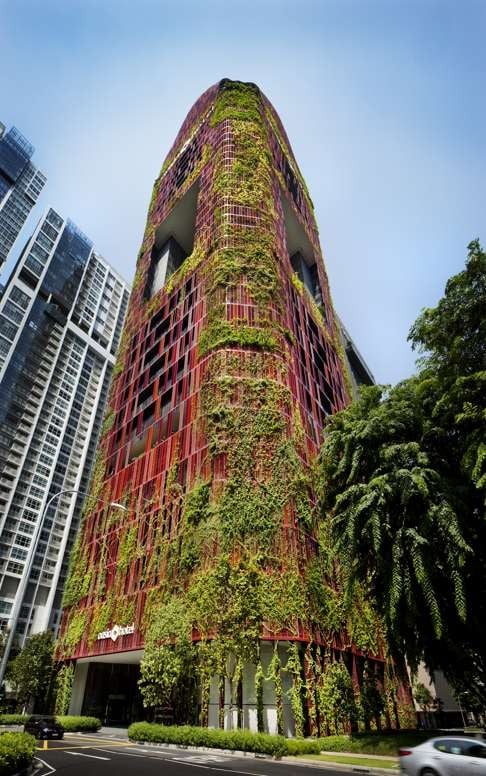
The entire tower is coated in greenery, which is another one of WOHA’s goals. Hassell says he has always been fascinated by the intersection of buildings and nature – even his early student projects were filled with greenery. The Parkroyal on Pickering, a hotel in Singapore completed in 2013, earned international acclaim for its thickly forested terraces, which contain more green space than Hong Lim Park across the street.
The Lion City makes it easy to coat buildings in vegetation. “Singapore has very low winds and year-round rainfall, constant humidity and a very constant sun path across the sky,” says Hassell. As Boeri’s Bosco Verticale proves, however, similar things can be done in any climate. “Basically the main condition to planting in buildings is that it’s the equivalent of a very exposed location on the ground. In cold climates it might be alpine plants, or seaside plants, which have high exposure to quite drying and strong winds off the sea. You’ll find in almost every climate there is a set of plants already adapted to such conditions.”
Here in Hong Kong, green walls and landscaped terraces have become a popular way to integrate nature into developments. Aedas’ Mongkok Residence, a serviced apartment building under construction on Sai Yee Street, will feature a verdant façade and podium gardens when it opens later this year.
Another goal of biophilic design is permeability. “The body enjoys breeze, it enjoys air movement – we expect it because it’s part of life,” says Griffiths. Though air conditioning creates dry, temperature-controlled spaces, it isn’t necessarily comfortable, and it certainly isn’t sustainable; air conditioning alone sucks up 30 per cent of the energy produced by Hong Kong’s coal-fired power plants.
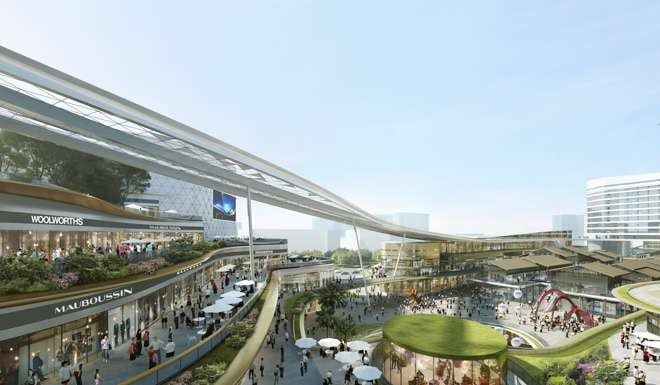
Aedas has made a point of enhancing natural ventilation in a number of projects, including the Oasis Mall in Sanya, Hainan Island, and a Singapore retail and cultural complex called The Star.
“The curves of the storefronts promote breezes, so there is a constant three-knot wind across the shopping mall,” says Griffiths. “You don’t have air conditioning but people love going there because it’s so cool.”
We should make buildings into a complete ecosystem
Biophilic design has yet another goal: biodiversity. “We should make buildings into a complete ecosystem,” says Malaysian Ken Yeang, one of the first architects in the world to employ biophilic principles in his work. “What I try to do in all my designs is not just put vegetation in my buildings, I create different types of habitats for different species.”
WOHA has created a scoring system to account for all of this, with points assigned for greenery, biodiversity, community space and self-sufficiency, as well the most abstract concept of “civic generosity” – the contribution of a development to a city’s public life. “You score for connecting habitats rather than creating isolated little pockets in the sky,” says Hassell. If the city is a garden, it’s worth remembering that a garden isn’t purely decorative – it’s a place that is alive.
Can Hong Kong become a biophilic city too? Not unless government relaxes restrictions
Hong Kong is a green city – on paper. Most of its land area is undeveloped and more than half of it is protected by country parks. Everyone has access to untrammelled nature.
Yet the places where people spend most of their time – from the high-rise housing estate of Tseung Kwan O, to the shopping malls of Causeway Bay and the office towers of Central – are anything but green.
And it’s not just because of widespread biophobia – fear of nature – in Hong Kong, where schoolchildren on field trips have been scared to touch the soil, and Stanley residents once opposed a tree-planting scheme because they might attract birds and insects, and spread diseases such as bird flu.
There are other challenges in Hong Kong, too, says Keith Griffiths, chairman of Aedas, an international architecture firm based in Hong Kong. The biggest problem is the city’s restrictive building code.
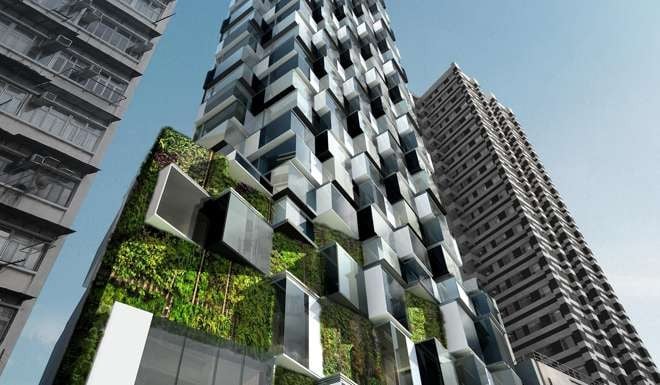
The Hong Kong government wants to control illegal development – we’ve had some very unfortunate basements and top-of-building developments,” he says. Though some green features are exempted from a development’s gross floor area, architects are forced to work within a very limited spectrum – only 500mm-deep planters are allowed, for instance. Any deviation from the building code’s prescriptions requires applying for special approval – a process that can drag on for years.
The biophilic architecture that results tends to be modest in scope, limited to tacked-on green walls and landscaped podium decks. Griffiths says this is a shame, because Hong Kong is otherwise well suited to architecture that embraces nature. Strong seasonal breezes can provide natural ventilation, and there are many opportunities to frame views of mountains and sea.
“All of that is calming, all of that brings us back with nature,” he says. Architects just don’t have the flexibility to embrace it.